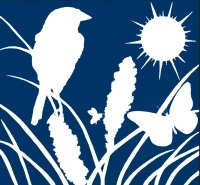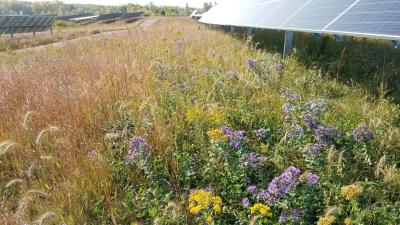
What is Habitat Friendly Solar?
The Habitat Friendly Solar Program supports the establishment of habitat for pollinators, songbirds and other species in addition to project co-benefits such as water management, grazing and soil health. Support is provided through a combination of technical resources, collaboration with conservation partners and project assessment forms.
This program was initiated to comply with Minnesota legislative requirements stating that “an owner of a solar site implementing solar site management practices may claim that the site provides benefits to gamebirds, songbirds and pollinators only if the site adheres to guidance set forth by the pollinator plan provided by the Board of Water and Soil Resources” (Minn. Stats. 216B.1642). Local governments and other landowners, as well as solar developers, can work toward meeting the standards. Some municipalities are also requiring that ground mounted solar projects are meeting Habitat Friendly standards to help ensure that projects are providing multiple landscape benefits and are maintained for the lifespan of the project.
Minnesota Habitat Friendly Solar Sites
The following file is a list of projects that are currently meeting the Habitat Friendly Solar Standard as of October 1st, 2024.
Minnesota Habitat Friendly Solar Sites (updated October 2024)
A BWSR partnership with M-RETS provides an opportunity for companies meeting the state Habitat Friendly Solar Standard the opportunity to sell habitat-friendly solar RECS as an additional revenue source from solar projects. M-RETS is a nonprofit organization that manages North America's most extensive clean energy tracking system. They use a software platform securely managing more than 300 million megawatts hours of clean and renewable electricity certificates (RECs). M-RETS uses BWSR’s list of habitat-friendly solar projects to enable issuance, transfer, sale, and retirement of RECs from habitat-friendly solar projects.
Program Updates
As the program has evolved it has an increased emphasis on providing technical guidance for projects ranging from small community solar projects to large utility scale solar projects. See the list of BWSR and partner resources at the bottom of this webpage. The program also has an increased focus on the recognition for solar developers, municipalities and schools that are working to accomplish landscape co-benefits as part of solar projects. BWSR updated the project assessment forms in 2025 based on feedback from stakeholders and information from site inspections. The forms are found below under "Steps for Meeting and Maintaining Standard Requirements."
During the summer of 2023 many Habitat Friendly Solar projects were monitored in partnership with Lauren Agnew, a PhD student from the University of Minnesota. The following are key outcomes that have been documented for the program.
-Over 40 native insect species have been documented at the sites including bees from 5 of 6 Minnesota bee families, and six bumble bee species.
-Habitat Friendly Solar Sites are also benefitting amphibians, reptiles, mammals, and birds. Some noteworthy species include treefrogs, toads, bull snakes, purple martins, sandhill cranes, and white-tailed deer. There is evidence of both small and large animal burrows, and ground nesting birds.
-We estimate that Habitat Friendly Solar sites sequester around 4,800 metric tons of carbon a year.
-Projects also capture around 8300 acre feet of water a year.
Steps for Meeting and Maintaining Standard Requirements
1) For design guidance refer to the DNR's Prairie Establishment & Maintenance Technical Guidance for Solar Projects (pdf) and BWSR's Sample Habitat Friendly Solar Planting Plan Specifications (pdf), and work with experts in the field of habitat restoration. Solar projects should be located outside of remnant prairie and important habitats, as identified by the DNR and federal wildlife agencies. As a general principle, at least 70% of the land area of sites needs to be planted with native seed mixes to meet the standard.
2) Fill out the Project Planning Assessment Form (updated 2.2025).
3) Submit the Project Planning Assessment Forms, the site plan with a map, a copy of the planting plan for the project, the seed mix (showing seeds/sq ft for each species) and any supplemental long term management plans and communications to protect the site from pesticide drift (see details in the assessment form) to local government staff who have approval responsibilities for the project, or to HFS@state.mn.us if local staff are not involved. Local staff who are approving projects will then coordinate with BWSR.
4) If projects meet the requirements listed above they will be added to a list of projects meeting requirements posted on the Board off Water and Soil Resources website and will be able to promote the array as a MN Board of Water and Soil Resources “Habitat Friendly Solar” project. A sample project sign is under development.
Steps to continue meeting the standard and remaining on the state list of projects
1) Projects need to be inspected yearly to identify any management needs. See the yearly monitoring forms below under "resources".
2) At the end of the third year of vegetation establishment (by December 31st) for the project have qualified natural resource staff with plant ID knowledge fill out the Established Project Assessment Form (updated Feb. 2025) and submit the form along with at least three site images that show the current vegetation to local government staff who have approval responsibilities for the project or other BWSR-designated representatives. In some cases, other site inspections reports can be submitted in place of the Established Project Assessment Form with approval by BWSR staff. Submitting these materials will keep you on the list of projects meeting standards and enable you to promote the array as a Minnesota “Habitat Friendly Solar” project. Yearly site inspections will be important to identify issues with weeds, erosion or other problems that need to be addressed. If projects have significant problems, additional discussion about potential solutions may be needed between project managers, local government staff and BWSR to ensure that projects can remain on the list of projects meeting standards.
2022 Habitat Friendly Solar Summit Presentations
In March 2022, BWSR and partners convened a virtual Habitat Friendly Solar Summit, "Partnerships for Solar Co-Benefits." Partners and sponsors of the Summit included Great Plains Institute, Connexus Energy, Xcel Energy, Enel, Natural Resource Services, MN Commerce Department, Clean Grid Alliance, MN Department of Agriculture, National Grid Renewables, and the University of Minnesota Extension. Presentations are linked below.
- 2022 Solar Summit Presentations
Summit Videos (Google Drive mp4)
The Big Picture of Solar Co-Benefits in Minnesota - Great Plains Institute
Perspectives from a Developer - National Grid Renewables (pdf)
Trends for Minnesota's Habitat Friendly Solar Program - BWSR (pdf)
Stearns County Case Study - Stearns County Environmental Services & Stearns SWCD (pdf)
Community Scale Solar Case Study (pdf) - Seed Mix Approval (pdf) - Vegetation (pdf) - Winona County, Winona SWCD, Natural Resource Services Inc., US Solar
Utility Scale Solar Case Study - Aurora Solar Project (pdf)
Groundwater Benefits
Q & A
Who can fill out the assessment forms and conduct the site assessments?
Independent contracting ecologists or SWCD staff who have strong plant identification skills can conduct the assessment.
How many acres can a single form cover?
One assessment form can be used for most contiguous sites, though more than one form may be needed for sites that have varying soil conditions across the site and/or upland and wetland plant communities that are significantly different in their composition, or sites that occur at multiple locations, when each site is greater than 20 acres including perimeter acreage.
For the “Project Planning Assessment Form”, where can I find more information about determining if the genetic origin of seed is within 200 miles?
See BWSR’s Native Vegetation Establishment and Enhancement Guidelines for more information on this topic as well as other topics related to seed quality and vegetation establishment.
What areas can be excluded from assessment areas?
Certain areas do not need to be included as part of the habitat assessments; these include roads, parking areas and buildings. Some sites have wetland areas that are dominated by aggressive invasive species including reed canary grass or hybrid/narrow-leaf cattail that is too difficult to convert to native vegetation. As long as these areas are mapped as separate from the planted areas they can be left out of the assessment.
What monitoring methods should be used for site assessments?
Qualified natural resource staff who are conducting the assessments should select a monitoring method that will provide an unbiased assessment that will be representative of the entire site rather than select portions of the site. Timed meanders or transects are common vegetation monitoring methods.
What if it is determined that a site no longer meets standards?
If sites no longer meet standards it is recommended that you work with contractors to assess what changes are needed to make the necessary improvements and improve scores.
Resources
Project Planning Assessment Form (updated 2-2025) (pdf)
Established Project Assessment Form (updated 2-2025 (pdf)
Monitoring Form & Meander Survey Guide (updated 02-2021) (pdf)
Fact Sheet on Protecting Conservation Plantings from Pesticides (pdf)
Sample Habitat Friendly Solar Planting Plan Specifications (pdf)
Guidance for Developing a Vegetation Establishment and Management Plan
Template Pesticide Letter (docx)
Local Government Solar Toolkits: The Great Plains Institute has developed toolkits for planning, zoning, and permitting of solar projects for Minnesota and other Midwest states.
Vegetative Managment on Habitat Friendly Solar-Sample Sequences New guidance has been developed to help ensure the successful establishment and management of Habitat Friendly Solar Project. This guidance was developed through a partnership with land management companies based on their field experience.
News
BWSR Snapshot Habitat Friendly Solar option takes off 2019 (pdf)
Monitoring Pollinators on Minnesota Solar Installations Monarch Joint Venture 2021 (pdf)
Highly compatible: pollinator-friendly solar projects and farming - MinnPost Opinion 2019 (web)
Pairing Solar with Stewardship - Connexus Energy 2022 (web)

